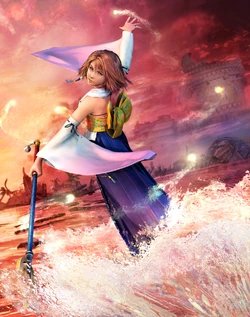No edit summary |
(Consistency in tense) |
||
| Line 7: | Line 7: | ||
Unlike in other games, summoners in ''Final Fantasy X'' do not have horns or wear horn-shaped headwear, since they are not of a separate tribe. However the [[Ronso]] promised to build a statue of Yuna with a horn on her head. This is a reference to the older games that did feature summoners with horns. |
Unlike in other games, summoners in ''Final Fantasy X'' do not have horns or wear horn-shaped headwear, since they are not of a separate tribe. However the [[Ronso]] promised to build a statue of Yuna with a horn on her head. This is a reference to the older games that did feature summoners with horns. |
||
| − | When Sin was finally destroyed, the [[Fayth]] |
+ | When Sin was finally destroyed, the [[Fayth]] disappeared from Spira and Summoners became obsolete as much of the population looked toward a new, and different, future. |
==Origin== |
==Origin== |
||
Revision as of 03:38, 15 August 2010

Yuna is a Summoner.
The summoners are practitioners of a sacred art, sworn to protect the people of Yevon. Only a chosen few become summoners, who call forth entities of greater power: the aeons. The aeons hear our prayers and come down to us. They are the blessing of Yevon.
Monk in Besaid Temple.
In the world of Spira in Final Fantasy X, the title of Summoner is given to skilled magic users who have trained in the process of summoning powerful beings known as Aeons. They do this in order to defeat Sin, a powerful monster who periodically returns to devastate the world. After completing their initial trial, each summoner undertakes a Pilgrimage to the temples of Spira to gather Aeons and develop their strength in body and mind. While many summoners compete to be the one to stop Sin when he appears, only one such summoner can succeed. That summoner, who invariably sacrifices his or her life in the process, is posthumously granted the title of High Summoner, and are worshiped by the followers of the religion of Yevon. Summoners also perform the Sending, a dance ritual that sends the spirits of the dead to the Farplane, lest they become fiends. It is unknown how summoning worked in Zanarkand.
Before the pilgrimage of Yuna, only five Summoners in 1000 years had defeated Sin: Lady Yunalesca, Gandof, Ohalland, Lady Yocun, and Yuna's father Braska. Other summoners appearing in the game include Maester Seymour Guado, Isaaru, Dona, Belgemine, Father Zuke, and Lady Ginnem.
Unlike in other games, summoners in Final Fantasy X do not have horns or wear horn-shaped headwear, since they are not of a separate tribe. However the Ronso promised to build a statue of Yuna with a horn on her head. This is a reference to the older games that did feature summoners with horns.
When Sin was finally destroyed, the Fayth disappeared from Spira and Summoners became obsolete as much of the population looked toward a new, and different, future.
Origin
Summoners in Final Fantasy X bear many conceptual similarities to the traditional Japanese Miko. Traditionally, miko are female shrine maidens who offered numerous services in the past, including divination, prayers, and in more desperate times when the shrines and temples were short of funds, prostitution. Most importantly, mikos were called upon to perform ceremonial dances, some of which were meant to drive away evil spirits and protect the shrine. The idea of dancing to ward off evil spirits in particular could roughly be used to describe the Sending.
Template:FFX
